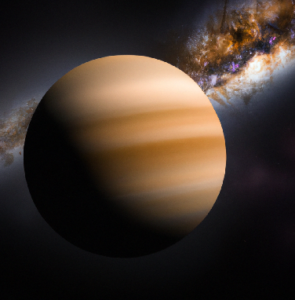How to See Titan With A Telescope?

Titan is the largest among 83 moons of Saturn and the second largest natural satellite in the solar system. Titan is the only moon that has a dense atmosphere. This is also known as the only object in space that has surface liquid. A small beginner telescope can spot them easily.
Quick Guide to Observe Titan
To confirm that Titan is visible in the sky and to learn its location and timing, consult the astronomy app. Use an automatic finder or point your telescope toward Titan once it has been aligned and is ready to be used. Titan will be clearly visible as a brilliant red disc. When Saturn is in opposition, you can see Titan and the other moons of Saturn at their best. To see Titan, you need a 6-inch telescope. If the sky is dark and clear, Titan can be seen with magnifications ranging from 150 to 250 times.
Before starting, choose a star chart. It will help with Titan observation.
There are several star charts available on the internet or play store that you can use to get the location of Titan. For example, Sky Map, Star Walk 2 Free, SkySafari, etc.
How to find Titan?
- Check the astronomy app to make sure that Titan is in the sky and find out its location and time.
- When your telescope is aligned and ready to use, aim the scope toward Titan or use an automatic finder. Titan will appear as a distinct bright red disc.
What is the best time to observe Titan?
The best time to view the moons of Saturn including Titan is when Saturn is in opposition. At this time Saturn reaches its highest luminosity. But at the same time, the moons have to be at their greatest elongation so that they do not get washed away by the glares of Saturn.
How to find Titan with your phone?
Install the stargazing app to find Titan. Hold your phone standstill and open the app. The app will update your screen in real-time and indicate what is there in from of you.
What can you see on Titan with a telescope?
- You need a 6-inch telescope to spot Titan. You will just be able to see a brownish or orangish star or dot with a 6-8 inch telescope.
- With a 14-inch telescope or greater, you will be able to see the orange disk of Titan. Titan has amazing features like lakes, rivers, etc. But unfortunately, they cannot be seen with amateur telescopes.
What telescope to see Titan?
Meade 8″ f/4 LX85 Astrograph Reflector, Orion 8″ f/8 Ritchey Chretien Reflecting OTA Telescope, Celestron Starsense Explorer 10″ Dobsonian Smartphone Telescope, Meade 10″ ACF LX90 Telescope, AG Optical 10″ iDK f/6.7 Imaging Dall Kirkham great telescopes to see Titan. A list of telescopes to see the planet Titan has more telescope options that can see Titan very clearly.
What size telescope to see Titan?
Your telescope should have at least 6-8 inches of aperture to find Titan easily. If the aperture is less than that, Titan will be fainter and can not be spotted. Even if the location is known, Titan can be misidentified from the stars. The more the aperture of your scope, the higher the resolution and limiting magnitude. If you use a telescope with more than a 14-inch aperture, you will get the disk-like view and the real orange color of Titan.
What magnification is required to see Titan?
Titan can be identified with magnification from 150-250x if the sky is dark and clear. If you use telescopes with large apertures, you will be able to magnify more and get a clearer view.
Enjoying Titan? Here are other things to see with a telescope
Titan is a nice night sky object to observe. With the same telescope you can get awesome view of Saturn. You will be able to see the Cassini Division between the A and B rings too. Viewing Saturn Through A Telescope can show you how to observe Saturn in the best ways with your telescope. However, you also can view the other planets of the solar system. There are myriads of star clusters and nebulae with amazing views. Moreover, Viewing the Sun Through A Telescope can guide you to observe the sun with full protection. However, you can choose one from List of things to see with a telescope and plan for a great observation session.
